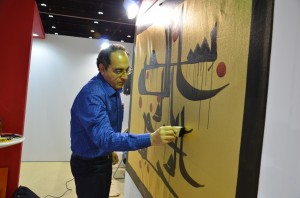By: SM Vahid M Jazayeri| Kufic Calligrapher
& Dr. Perette Michelli | Art and Architectural Historian
Place | ING Creativity, Dubai
Dates | 14 Oct 2016
Time | 12:30 – 18:30 (6 hours)
Level | Beginner | No previous knowledge of Arabic lettering needed
Description | Discover the Qalam (Arabic wooden pen) and let it take you on a journey to learn how to write in Kufic Calligraphy on Manuscripts together with well-established calligrapher Vahid M. Jazayeri who has more than 25 years experience in the field.

Key Takeaways
• Learn about Kufic Calligraphy and it’s History
• Get acquainted with the Kufic Calligraphy Alphabet
• Learn how to use a Qalam (traditional Arabic wooden pen)
• Write manuscripts in Kufic Calligraphy
What is Kufic Calligraphy? | Kufic is the most ancient form of Quranic writing with over 1400 years history and evolution and the first method of writing in ancient Quran manuscripts. It is also the root of contemporary writing styles in Arabic, Turkish Ottoman, Urdu, Farsi, Traditional Malaya and other languages of Western Asia and North Africa.
 Vahid M. Jazayeri Biography | Vahid M. Jazayeri is an established calligrapher, researcher, graphic designer, and expert in early Arabic Kufic script. He holds a Bachelor of Art in Graphics and has been awarded the Excellence in Art Certificate by the ministry of culture, the equivalent of an honorary Ph.D.
Vahid M. Jazayeri Biography | Vahid M. Jazayeri is an established calligrapher, researcher, graphic designer, and expert in early Arabic Kufic script. He holds a Bachelor of Art in Graphics and has been awarded the Excellence in Art Certificate by the ministry of culture, the equivalent of an honorary Ph.D.
Vahid began his study on Thuluth script in 1982 and his study on Naskh scripts in 1991. After nearly ten years of training he began teaching and within a year he was developing two complementary fields: historical calligraphy in a range of media (ceramics, coins, plaster and stone, manuscripts) and contemporary type design.
 Perette Michelli Biography | Dr. Michelli gained her Ph.D. in 1989 and is a multi-disciplinary historian of medieval and later art. Her understanding of the medieval deployment of classical aesthetics generated a special interest in the use of visually distinctive script styles, textual traditions that perpetuate mistakes and scribal errors, and inscriptions that seem to lack purpose or information, or that seem to include errors, flaws, or meaningless components. She has been researching medieval Islamic art and architecture for eight years and has a particular interest in “benedictory” inscriptions on medieval Islamic objects.
Perette Michelli Biography | Dr. Michelli gained her Ph.D. in 1989 and is a multi-disciplinary historian of medieval and later art. Her understanding of the medieval deployment of classical aesthetics generated a special interest in the use of visually distinctive script styles, textual traditions that perpetuate mistakes and scribal errors, and inscriptions that seem to lack purpose or information, or that seem to include errors, flaws, or meaningless components. She has been researching medieval Islamic art and architecture for eight years and has a particular interest in “benedictory” inscriptions on medieval Islamic objects.
Dr. Michelli is an independent scholar with extensive teaching experience in high schools, art schools, colleges and universities in England and in the American Midwest.
Earlybird Discounted Ticket (available for limited time) | 163 USD (599 AED)
Regular Workshop Ticket | 210 USD
Workshop ticket at the Door | 240 USD (880 AED)
Please click here to purchase your ticket.
For more information
Follow us in Instagram / Facebook

